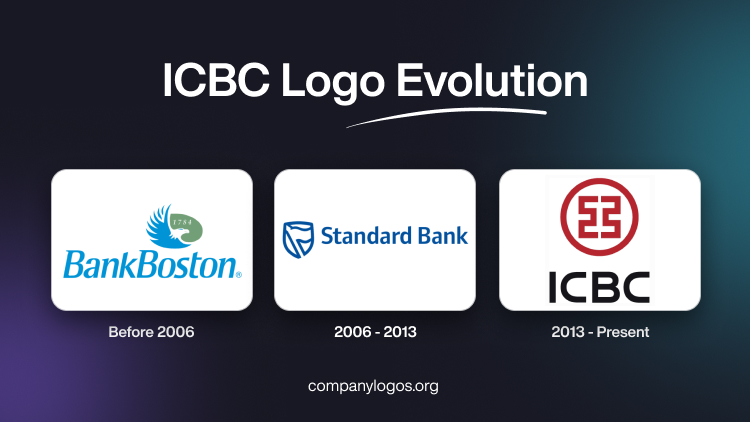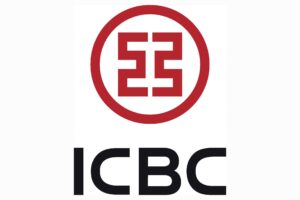
The Industrial and Commercial Bank of China (ICBC) is arguably the largest bank in the world when it comes to market capitalisation and total assets held. This state-owned banking behemoth provides a range of services, such as investment banking, corporate and retail banking, and asset management. The bank plays an important role in the economic development of the country by financing major infrastructure projects, facilitating global trade and investments, and supporting companies of various sizes.
The logo of the Industrial and Commercial Bank of China (ICBC) has a rich history, and its symbolic evolution is closely tied to the bank’s origins and identity as a major financial institution in China. The article explores the evolution of the ICBC logo over the years.
The Genesis of the ICBC Logo (Before 2006)
The first logo of the ICBC bank was created for BankBoston, its erstwhile name. It featured a horizontally oriented oval emblem formed out of a flying eagle in blue and white on a green background. There was the date “1784” written on the green background in white. Below the emblem was written the bank name “BankBoston” in sky-blue italics and using a narrowed sans-serif typeface.

(2006 – 2013)
In 2006, the logo featured the wordmark “Standard Bank” to portray the new name of BankBoston in blue title case and using a modern and elegant sans-serif typeface. To the left of the wordmark appeared the emblem comprising a blue contoured crest with a waving flag inside.

(2013 – Present)
The ICBC logo comprises a circular emblem containing a crimson seal, which is a traditional Chinese symbol of authenticity and trust. Below it is mentioned the ICBC wordmark in a bold black sans-serif typeface in uppercase.

The Elements of the ICBC Logo
Font
The ICBC (Industrial and Commercial Bank of China) logo uses a bold, uppercase modern sans-serif typeface for the “ICBC” wordmark. The typeface is designed to be solid and strong to reflect the stability and authority of the bank. The Chinese characters below the “ICBC” text are also rendered in a simple, legible style for consistency and clarity.
Colour
The primary colour scheme of the ICBC logo is red and black. The logo features a prominent red circular emblem at the top. Here, red symbolises prosperity and good fortune and aligns with traditional Chinese values. Further, the “ICBC” text and accompanying Chinese characters are in black. The black colour provides a strong contrast against the red emblem and ensures high visibility and legibility.
The History of ICBC
The Industrial and Commercial Bank of China (ICBC) was officially established on January 1, 1984, in Beijing. It was formed as part of sweeping reforms to modernise the financial system in China. Before the creation of ICBC, China used to operate under a monobank system where the People’s Bank of China (PBC) managed both central banking and commercial banking functions. However, after the Third Plenary Session of the 11th Central Committee of the Communist Party of China in December 1978, reforms were undertaken to separate these functions. In September 1983, the State Council decided that the PBC would serve exclusively as the central bank, while ICBC would take over industrial and commercial credit and savings operations.
ICBC quickly became the largest bank in China and initially focused on serving the financial needs of the country’s industrial and commercial sectors. It played a key role in supporting large and medium-sized state-owned enterprises, expanding its services to include credit cards, international business, and electronic banking.
In the 1990s, ICBC began to diversify its offerings and expand its geographic footprint. The bank opened its first overseas branch in Singapore in 1993, which was followed by the establishment of a branch in Luxembourg in 1999, which would later become its European headquarters. In 2000, ICBC acquired Union Bank of Hong Kong and rebranded it as ICBC (Asia). It subsequently expanded its presence in Hong Kong by acquiring Fortis Bank Asia HK’s retail and commercial banking operations in 2004.
Over the decade, ICBC continued to grow rapidly, fuelled by China’s economic boom and the aggressive expansion strategy adopted by the bank. By 2006, ICBC served 2.5 million corporate customers and 150 million individual customers.
A significant milestone in the bank’s history came in 2005 when ICBC was restructured into a joint-stock limited company, officially becoming the Industrial and Commercial Bank of China Limited. This restructuring was part of a broader effort to modernise China’s banking sector and prepare major banks for global competition. The bank underwent comprehensive audits and asset evaluations to ensure transparency and regulatory compliance.
On October 27, 2006, ICBC was simultaneously listed on the Shanghai Stock Exchange and the Hong Kong Stock Exchange in what was then the world’s largest initial public offering (IPO). It raised US$21.9 billion and surpassed the previous record set by Japan’s NTT DoCoMo. This landmark event marked ICBC’s transformation into a global financial powerhouse.
Following its public listing, ICBC accelerated its globalisation strategy by establishing branches and subsidiaries in major financial centres worldwide, including Europe, the Americas, Africa, and Asia. The bank also engaged in high-profile acquisitions, which included purchasing a majority stake in Standard Bank Plc’s London global markets business in 2015.
ICBC’s international network now covers key cities such as Paris, Amsterdam, Brussels, Milan, Madrid, Barcelona, Warsaw, Lisbon, and Mumbai, among others. The bank offers a comprehensive range of financial services, including retail banking, corporate banking, treasury operations, and asset management.
Today, ICBC is recognised as the largest bank in the world by total assets. It plays a vital role in both China’s domestic economy and the global financial system. The bank’s evolution from a specialised state institution to a publicly listed global giant shows the broader transformation of China’s economy and financial sector over the past four decades.
Interesting Facts About ICBC
- ICBC is the largest bank in the world by total assets, with over $5 trillion in assets as of 2024.
- Founded in 1984, ICBC rapidly grew to become China’s largest bank. It serves more than 500 million personal customers and millions of corporate clients globally.
- It operates in over 40 countries, with a vast network of more than 16,000 domestic branches and over 400 overseas institutions.
- ICBC became the world’s largest bank by total assets in 2012 and has maintained this position ever since.
- The bank was ranked first on the Forbes Global 2000 list of the world’s top public companies in 2015. It was among the most profitable companies globally and ranked fourth in profitability with $45 billion, according to Forbes in 2022.
- The bank maintains a robust Tier 1 capital ratio of over 13%. This indicates solid financial health and effective risk management, with a non-performing loan ratio below 1.5%.
- ICBC was the first Chinese bank to gain US federal approval to open a branch in New York City in 2008. It became the largest office tenant in Trump Tower as of 2012.
- It has played a significant role in financing China’s Belt and Road Initiative. It lent over $100 billion to projects in participating countries and operated 124 branches in those regions as of 2019.
- ICBC has been designated a systemically important bank by the Financial Stability Board since the inception of the list. This underscores its critical role in ensuring global financial stability.
- The bank has a history of innovation, for it launched services such as robo-advisors for wealth management in 2017. It is also the only custodian bank in mainland China to independently develop custody business systems.
- ICBC has been involved in significant acquisitions, including the purchase of a 70% stake in the Bank of East Asia in 2009 and Standard Bank’s London global markets business in 2015.
- It faced a ransomware attack in November 2023 which targeted its US unit and disrupted clearing of US Treasury trades.
Finally
The ICBC logo encapsulates the bank’s mission and values. It also reflects its origins, growth, and aspirations as a leading global financial institution with strong Chinese characteristics.